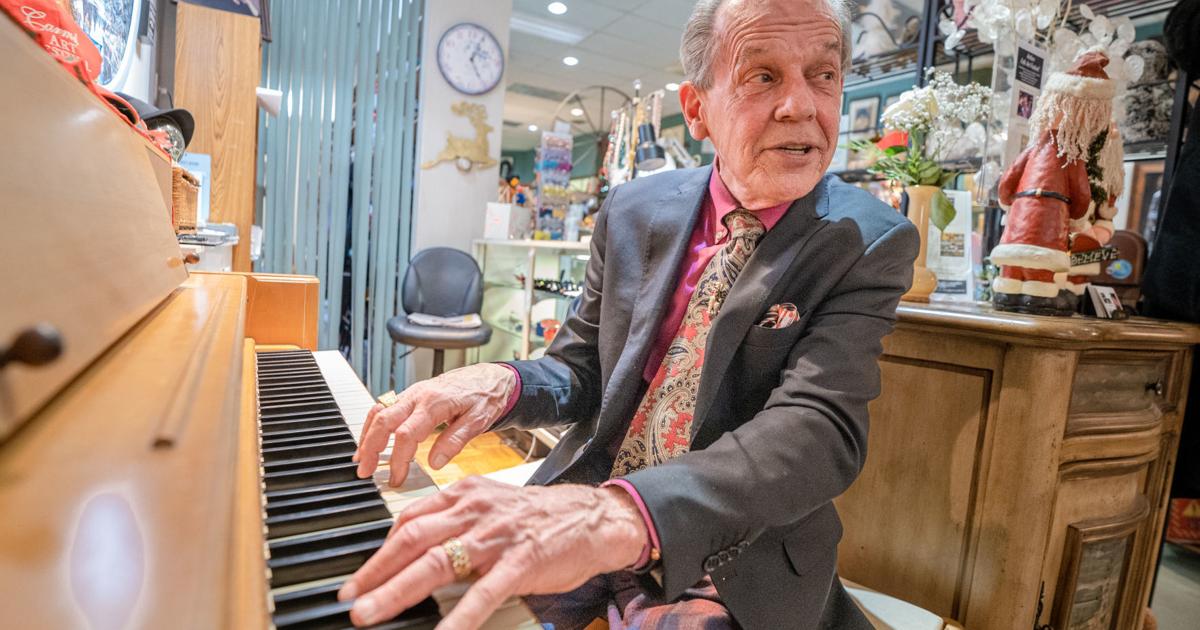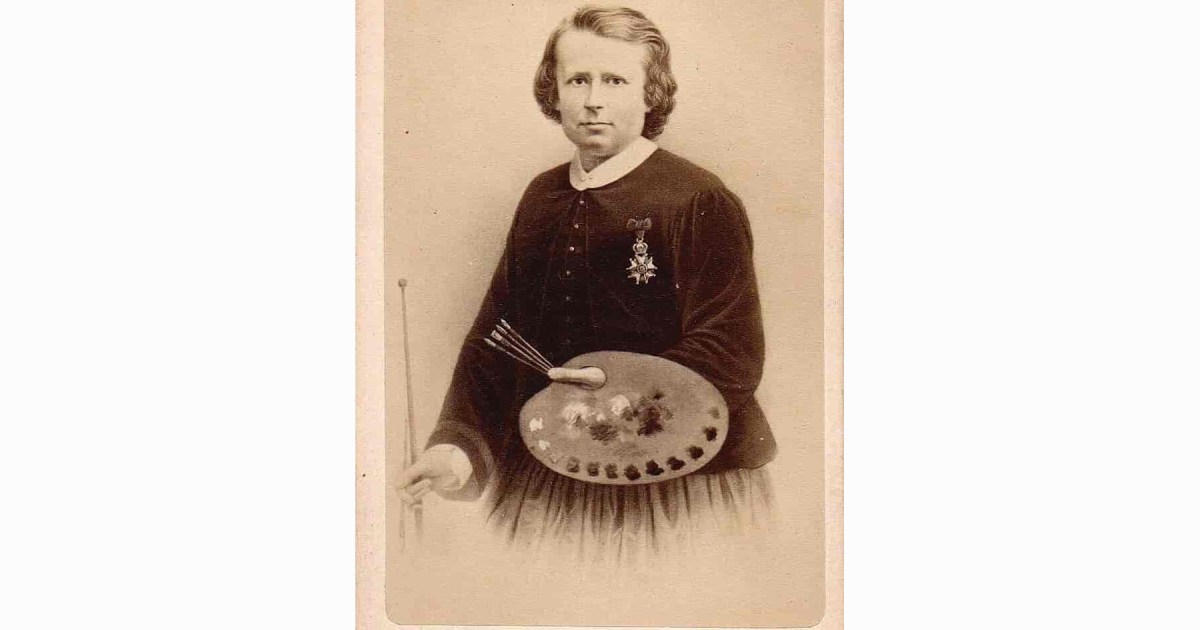
Career performer, artist finds community in new hometown of Arthur | Art
ARTHUR — As he weaved past the stuffed animals, designer handbags and expensive paintings in his art gallery in downtown Arthur, Jerry Winters posed a question.
“Do you want me to play something for you?” he asked.
Dressed in a navy blue blazer, pink shirt, orange-and-blue plaid pants and a gold paisley tie with a matching pocket square, his style directly contrasts with the small town known for its significant Amish and Mennonite community.
Minutes earlier, a horse and buggy passed by his store, which is packed with expensive artwork, some worth as much as six figures, he said.
The 80-year-old sat down at his Steinway & Sons upright piano behind the counter, and as his fingertips hit the keys, his eyes lit up, and his voice took on a British accent.
He swayed back and forth as he sang an upbeat tune from the musical “Stop the World — I Want To Get Off,” occasionally turning his head toward the empty store as if he were addressing an audience.
At times, he’d improvise lyrics to reference the ongoing conversation.
Winters is comfortable performing in front of an audience, whether it’s a crowd of hundreds or a solitary reporter. He spent much of his eight decades on the road, performing in Broadway musicals, at piano bars and other venues around the world, and on USO tours during the Vietnam War.
“When you cut me,” he said, “I bleed notes.”
Little in Winters’ life would have foretold his move to a small, modest community in East Central Illinois.
Early start
His career began as a child. When he and his siblings were out on the road with their father, a well-known performer, he’d pick up odd jobs in whatever town they found themselves in.
One time, he said, he worked as a rodeo clown. Other times, he’d perform at a local venue or in a play.
“I worked every single thing I could out of the business,” he said. “My dad was very encouraging of us to learn everything that we could, so we took tap, ballet, we had to take voice, we had to take acting, we had to be proficient on the piano, not just to play, but music theory was important.”
Winters kept performing through adulthood, molding himself into a classic variety performer, even making forays into opera and comedy. Soon, though, he became well-known for another form of artistry.
From the time he was a child, when he took delight in paint by numbers, Winters loved to paint. When he went on the road, his supplies always went with him. Usually, he’d give away his intricate folk-art paintings or sell them for a small fee.
After he began dating his future wife, Joan, that changed.
Down to business
Joan, who had grown up in poverty on a farm in southern Illinois that lacked running water or electricity, had built herself into an accomplished businesswoman, eventually becoming a senior marketing director for Mary Kay shortly after its founding. She encouraged him to view his art as a career.
“She said very tenderly one day: ‘Don’t be offended when I say this, Jerry. But some of your artist friends and your musician friends are some of the worst businessmen I’ve ever seen in my life,’” he said. “She said, ‘Would you guys like some help, do you think? You can’t afford me, but I’ll do it for you.’”
Jerry obliged, and Joan took over the management of his artistry, forbidding him from giving away paintings without clearing it with her. She quickly procured a contract with Sun-Maid Raisins to produce paintings of the California Raisins, and his paintings began selling for thousands.
Still a touring performer, he became well-known for his paintings, which are displayed around the world.
Joan eventually sold her shares in Mary Kay for a significant sum of money to open up an art gallery in Carmel-by-the-sea, Calif., where they settled. The small, quirky town about 120 miles south of San Francisco was formed as an artists’ haven and came to be known for the poets, artists and actors who called it home, including one-time Mayor Clint Eastwood, who happened to be the Winters’ neighbor.
All the while, the couple would travel to Illinois regularly to visit Joan’s family, and a few decades ago, on a whim, they decided to buy a large house in Decatur. Several years ago, the couple decided they’d open a new gallery, but they weren’t sure where it would be located.
“I said, ‘What are we going to do next?’” Jerry Winters said. “She said, ‘I’m thinking about Arthur, seriously.’ And I said, ‘Who’s Arthur?’ She said, ‘It’s a lot like Carmel was when we found Carmel 50 years ago.’”
Back to Illinois
In 2015, Joan Winters Fine Art Gallery opened in downtown Arthur, next door to an advertising firm named Amish Country Marketing.
Immediately, Jerry realized he was a fish out of water. His wife mentioned he might want to tone down his choice in clothing. He was surprised when people stopped in to chat, bringing them meals to welcome them to the community.
It was a different world, he found, than the theater community, where he said he learned to be cautious with his trust.
In Arthur, though, his guard came down.
“It’s a whole different (thing) out there,” he said. “I can truly say that I’ve never been more relaxed in my life. I have made more friends here over the last year than I have in my entire life. I mean real friends. You have to invest in friends. And I can just be me and not have to be protective. So, it’s been a rich, rich moment of growth.”
Putting down roots
Four years ago, the couple moved into a house a few blocks away from their gallery. Shortly after, they sold their home in Carmel-by-the-Sea. On Thanksgiving of last year, Joan died at age 93, a loss Jerry said he’s still processing.
The community, though, has made it bearable.
“People came in here and helped me and I was like, ‘I can’t process that,’” he said. “I haven’t cooked in a year. There were always fresh casseroles in little zipper containers on my door here, continuing daily.”
Jerry, of course, still finds notoriety with his paintings. While he made the difficult decision to sell his home in France, the Museum of Naive Art in Nice recently bought two of his paintings.
His career as a performer, though, ended when he retired eight years ago.
When he can find a willing friend, customer or interviewer, of course, he’ll happily sit down and play a tune. But in Arthur, he’s found a new kind of comfort that was foreign to him.
“People have time for each other,” he said. “They have lunch for three hours and sit there and visit and just do special things, you know? You get used to that here. It’s wonderful. You can really slow it down and listen to people.”





